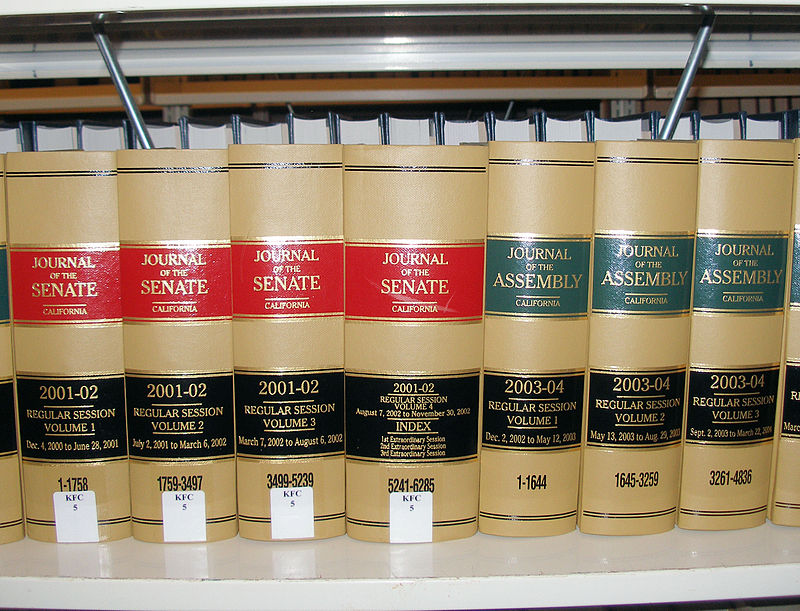
Journals of the California Legislature. (Photo: Wikipedia)
Economic Impact Analysis Under the APA
The economic impact analysis is an important part of a state agency’s rulemaking activity
By Chris Micheli, October 25, 2021 2:27 am
As part of California’s Administrative Procedure Act (APA), executive branch agencies that promulgate regulations are required to conduct an economic impact analysis. What is that analysis and how have the courts interpreted agency actions to comply with this statutory mandate?
Under existing law, all regulations are required to have an analysis of the potential economic impact of a regulation. Specifically, pursuant to Government Code Section 11346.3, a state entity proposing to adopt, amend, or repeal any regulation must assess the potential for adverse economic impact on California business enterprises and individuals.
These rulemaking entities must also avoid the imposition of unnecessary or unreasonable regulations or reporting, record keeping, or compliance requirements. Unfortunately, this short analysis is done by completing the Economic Impact Statement, which is a 5-page, fill-in-the-blanks form, which is probably sufficient for most regulations.
The state entity, prior to submitting its proposed regulatory action to the Office of Administrative Law to begin the formal rulemaking process (i.e., part of the “initial statement of reasons”), must consider the proposal’s impact on business, with consideration of industries affected including the ability of California businesses to compete with businesses in other states. The state entity must even consider information supplied by interested parties.
What does this economic assessment include? The state entity must assess whether and to what extent it will affect the following:
- The creation or elimination of jobs within the state.
- The creation of new businesses or the elimination of existing businesses within the state.
- The expansion of businesses currently doing business within the state.
- The benefits of the regulation to the health and welfare of California residents, worker safety, and the state’s environment.
Under the APA, an economic impact assessment of a proposed regulation has three phases: first, the agency makes an initial, provisional determination of whether the proposed rule will have a significant adverse economic impact on businesses; second, during the public comment period, affected parties may comment on the agency’s initial determination and supply additional information relevant to the issue; and, third, when the agency issues its final decision and statement of reasons, it must respond to the public comments and either change its proposal in response to the comments or explain why it has not. Western States Petroleum Association v. Board of Equalization (2013) 57 Cal. 4th 401
Under the economic impact assessment requirement of the APA, a rulemaking agency making an initial disclosure must include facts, evidence, documents, or testimony relief on to support an initial determination that the action will not have a significant adverse economic impact on business. John R. Lawson Rock & Oil Inc. v. State Air Resources Board (2018) 20 Cal.App. 5th 77
The APA broadly requires consideration of significant, statewide adverse economic impacts directly affecting business and the APA likewise requires an analysis of several factors that are broadly drafted in a manner which does not suggest solely inter-state impacts. An agency is not permitted under the statutory scheme to ignore evidence of impacts to specific segments of businesses already doing business in California from benefits to other in-state businesses when proceeding under the APA.
In addition, if the agency’s proposed regulatory amendments placed the state’s thumb on the scale for one group of in-state businesses over another, it needed to consider that impact. Moreover, in failing to properly respond to the comments regarding intra-state competition issues, the agency failed to abide by its obligations under the APA in either form or substance. John R. Lawson Rock & Oil Inc. v. State Air Resources Board (2018) 20 Cal.App. 5th 77
A regulation is not necessarily invalid under the APA even if it has a significant adverse economic impact on business. Under the APA, the provision stating that, if an agency makes an “initial determination that the action will not have a significant, statewide adverse economic impact directly affecting business, it shall make a declaration to that effect in the notice of proposed action.”
The agency’s determination does not need to be conclusive, and the agency need not assess or declare all adverse economic impact anticipated. An agency’s initial determination of the economic impact of a regulation under the APA calls for an evaluation based on facts. Mere speculative belief is not sufficient to support an agency declaration of its initial determination about the economic impact of a regulation under the APA, and the agency must provide in the record any “facts, evidence, documents, testimony, or other evidence” upon which it relies for its initial determination. California Association of Medical Products Suppliers v. Maxwell-Jolly (2011) 199 Cal.App. 4th 286
As the reader can ascertain, the economic impact analysis is an important part of a state agency’s rulemaking activity and must be duly considered before taking final action on a regulation.
- Third Quiz on Where Areas of Law Are Found in the California Codes - December 30, 2025
- Management of Unclaimed Property - December 30, 2025
- Petitions and Responses in Arbitration - December 29, 2025




